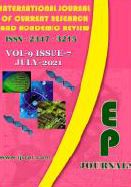Abstract Volume:9 Issue-7 Year-2021 Original Research Articles
 |
Online ISSN : 2347 - 3215 Issues : 12 per year Publisher : Excellent Publishers Email : editorijcret@gmail.com |
Bamboo plays manifold role in day-to-day life of rural community. However, in Ethiopia it is utilized below its potential due to lack of scientific knowledge and awareness on its management and utilization. To fulfill needs of rural people, recording farmers’ traditional knowledge and effective conservation and sustainable utilization of the bamboo resource is very vital. Therefore, the overall objective of this study was to identify Farmers Management Practice of highland bamboo stands and to characterize and select superior land races of high land bamboo species (Arundinaria alpina) at Bore District, Guji Zone, Southern Ethiopia. Primary data was collected through Focus group discussion, Key informant interview and Questioner survey. The result of the study indicated that, local people have experience of developing bamboo stands using their indigenous knowledge. Bamboo growers’ of the study District have their own calendar of bamboo planting time and based on their criteria easily identified commonly known land races of high land bamboo species of the area. Based on the farmers’ criteria, the three commonly known land races of Arundinaria alpina such as Okotu, Shanto and Uratiti were collected from Bore District. All collected land races of high land bamboo species (Arundinaria alpina) were planted in a randomized complete block design (RCBD) by three replications at spacing of 3m between seedlings, 3m between blocks and 2m between plots. As the results of this study showed that, in terms of their survival rate and number of shoots, all collected land races of Arundinaria alpina were not significantly different at P< 0.05. However, Okotu land race of High land bamboo species was significantly higher (at P<0.05) than High land bamboo species of Uratiti and Shanto land races by culm diameter, culm height, internode length and number of node. Based on the findings of this study, from all collected land races of Arundinaria alpina, Okotu land race was superior than the remaining land races of high land bamboo species (Arundinaria alpina). Therefore, for this superior highland bamboo land race sustainable conservation should be vital for long term utilization of the resource. In addition, based on their accumulated experience, bamboo growers of the study District have deep knowledge of bamboo management practice. Therefore, integration of their traditional knowledge with modern Scientific Knowledge is very important for sustainable management and utilization of bamboo resources.
How to cite this article:
Aschalew Emire and Sintayew Demise. 2021. Farmers’ Management Practice and Characterization Study of Commonly known Land Races of High Land Bamboo Species (Arundinaria alpina) at Bore District, Guji Zone, Southern Oromia.Int.J.Curr.Res.Aca.Rev. 9(7): 26-33doi: https://doi.org/10.20546/ijcrar.2021.907.004



Quick Navigation
- Print Article
- Full Text PDF
- How to Cite this Article
- on Google
- on Google Scholor
- Citation Alert By Google Scholar
